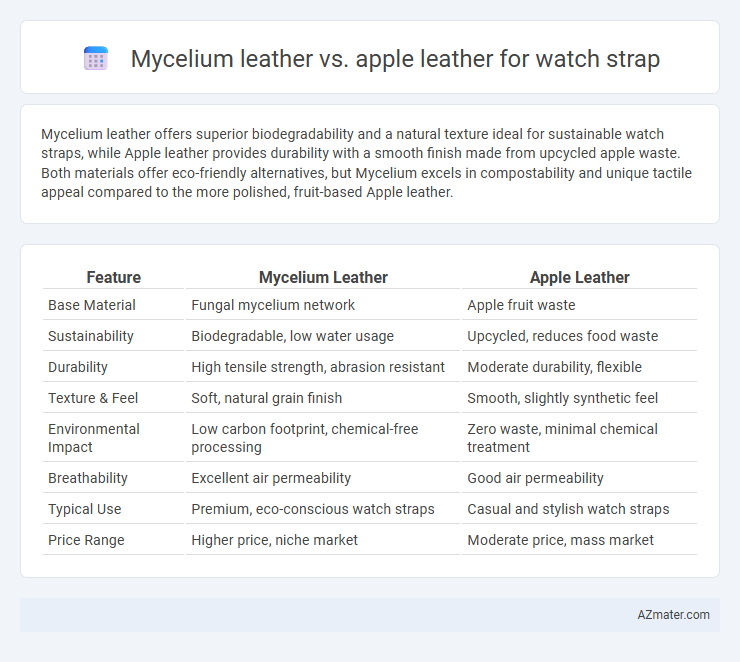Mycelium leather offers superior biodegradability and a natural texture ideal for sustainable watch straps, while Apple leather provides durability with a smooth finish made from upcycled apple waste. Both materials offer eco-friendly alternatives, but Mycelium excels in compostability and unique tactile appeal compared to the more polished, fruit-based Apple leather.
Table of Comparison
| Feature | Mycelium Leather | Apple Leather |
|---|---|---|
| Base Material | Fungal mycelium network | Apple fruit waste |
| Sustainability | Biodegradable, low water usage | Upcycled, reduces food waste |
| Durability | High tensile strength, abrasion resistant | Moderate durability, flexible |
| Texture & Feel | Soft, natural grain finish | Smooth, slightly synthetic feel |
| Environmental Impact | Low carbon footprint, chemical-free processing | Zero waste, minimal chemical treatment |
| Breathability | Excellent air permeability | Good air permeability |
| Typical Use | Premium, eco-conscious watch straps | Casual and stylish watch straps |
| Price Range | Higher price, niche market | Moderate price, mass market |
Introduction to Sustainable Watch Straps
Mycelium leather offers a biodegradable, mushroom-based alternative with superior breathability and minimal environmental impact compared to conventional materials, making it ideal for eco-conscious watch straps. Apple leather, derived from apple waste, provides a durable, vegan-friendly option that repurposes food byproducts, reducing landfill contributions while maintaining a sleek appearance. Both materials exemplify innovative approaches to sustainable watch straps by combining functionality, aesthetics, and environmental responsibility.
What is Mycelium Leather?
Mycelium leather, derived from the root structure of fungi, offers a sustainable and biodegradable alternative to traditional materials, including Apple leather made from apple waste. This innovative leather mimics the texture and durability of genuine leather while minimizing environmental impact through faster growth processes and reduced chemical use. Compared to Apple leather, Mycelium leather is praised for its breathability and natural antimicrobial properties, making it an ideal choice for watch straps requiring comfort and longevity.
Understanding Apple Leather
Apple leather, crafted primarily from apple peels and cores, offers a sustainable and eco-friendly alternative to traditional and mycelium leather for watch straps. This innovative material boasts excellent durability, water resistance, and a soft texture that enhances comfort and style in everyday wear. Compared to mycelium leather, apple leather's unique natural fiber composition provides superior breathability and a lower environmental footprint during production.
Production Processes Compared
Mycelium leather is produced through the cultivation of fungal root structures in controlled environments, resulting in a sustainable, biofabricated material with low water and energy usage. Apple leather is derived from apple waste, primarily apple peels and cores, which are processed, dried, and combined with polyurethane to create a flexible, leather-like material. Both materials offer eco-friendly alternatives to traditional leather, but mycelium leather's growth-based production significantly reduces chemical processing compared to the fruit waste-based synthesis of apple leather.
Durability and Longevity
Mycelium leather offers superior durability and longevity for watch straps due to its naturally resilient fungal fibers, which resist wear and tear while maintaining flexibility over time. Apple leather, derived from apple waste, provides moderate durability but tends to show signs of aging faster, including potential cracking and fading. Consumers seeking a longer-lasting, eco-friendly watch strap often prefer mycelium leather for its enhanced strength and extended product lifespan.
Environmental Impact
Mycelium leather, derived from mushroom roots, offers a highly sustainable alternative to traditional materials due to its rapid growth and minimal resource use, producing significantly lower carbon emissions than Apple leather, which is manufactured from apple peels and cores as byproducts of juice production. Both materials reduce reliance on animal leather, but Mycelium leather's biodegradability and lack of synthetic additives make it more environmentally friendly, promoting circular economy principles. The environmental impact of Mycelium leather includes reduced water consumption and no toxic chemical usage, whereas Apple leather requires energy-intensive processing and often incorporates polyurethane, which affects its biodegradability.
Look and Feel: Aesthetic Differences
Mycelium leather watch straps exhibit a natural, textured surface with earthy tones, offering a rustic and organic aesthetic that appeals to eco-conscious users. Apple leather provides a smoother, more uniform finish with subtle grain patterns, delivering a modern and polished look often favored for formal or tech-inspired accessories. Both materials balance durability and comfort, but Mycelium leather emphasizes artisanal warmth while Apple leather highlights sleek sophistication.
Comfort and Wearability
Mycelium leather offers exceptional breathability and flexibility, making it highly comfortable for watch straps that require long-term wear without causing skin irritation. Apple leather, derived from apple waste, provides a smooth texture and moderate durability but may lack the same level of softness and moisture-wicking properties as mycelium leather. Both materials are eco-friendly alternatives to traditional leather, yet mycelium leather is often preferred for its lightweight feel and superior wearability in daily use.
Cost and Market Availability
Mycelium leather for watch straps offers a sustainable alternative but tends to have a higher price point due to limited large-scale production and specialized processing costs. Apple leather, derived from apple waste, is generally more affordable and achieves broader market availability as several manufacturers integrate it into mainstream fashion accessories. The wider distribution and lower cost of apple leather make it a popular choice for eco-conscious consumers seeking budget-friendly options.
Which is Better for Watch Straps?
Mycelium leather offers superior breathability and durability compared to Apple leather, making it more suitable for extended wear in watch straps. Apple leather, made from fruit waste, provides an eco-friendly alternative with a softer texture but tends to be less resistant to daily wear and sweat. For watch straps requiring longevity and comfort, mycelium leather is generally considered the better choice due to its natural strength and moisture-wicking properties.

Infographic: Mycelium leather vs Apple leather for Watch strap
 azmater.com
azmater.com